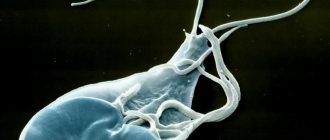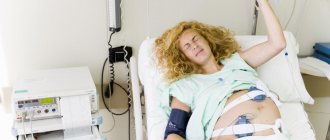Appendicitis is inflammation of the appendix (appendix). This pathology is one of the most common among diseases of the gastrointestinal tract. According to statistics, appendicitis develops in 5-10% of all inhabitants of the planet. Doctors cannot predict the likelihood of its occurrence in a particular patient, so there is little point in preventive diagnostic studies. This pathology can suddenly develop in a person of any age and gender (with the exception of children who are under one year old - they do not have appendicitis), although in women it occurs a little more often. The most “vulnerable” age category of patients is from 5 to 40 years. Before 5 and after 40 years, the disease develops much less frequently. Before the age of 20, pathology occurs more often in men, and after 20 - in women.
Appendicitis is dangerous because it develops rapidly and can cause serious complications (in some cases life-threatening). Therefore, if you suspect this disease, you should immediately consult a doctor.
The vermiform appendix is an appendage of the cecum, hollow inside and without a through passage. On average, its length reaches 5-15 cm, and its diameter usually does not exceed a centimeter. But there are also shorter (up to 3 cm) and longer (over 20 cm) appendixes. The vermiform appendix arises from the posterolateral wall of the cecum. However, its localization relative to other organs may be different. The following location options are available:
- Standard. The vermiform appendix is located in the right iliac region (in the anterior part of the lateral region, between the lower ribs and pelvic bones). This is the most “successful” location from a diagnostic point of view: in this case, appendicitis is detected quickly and without any particular difficulties. Standard localization of the appendix is observed in 70-80% of cases.
- Pelvic (descending). This location of the appendix is more common in women than in men. The vermiform appendix is located in the pelvic cavity.
- Subhepatic (ascending). The apex of the appendix “looks” at the subhepatic recess.
- Lateral. The appendix is located in the right lateral paracolic canal.
- Medial. The vermiform appendix is adjacent to the small intestine.
- Front. The appendix is located on the anterior surface of the cecum.
- Left-handed. It is observed with a mirror arrangement of internal organs (that is, all organs that should normally be on the right side are on the left, and vice versa) or strong mobility of the colon.
- Retrocecal. The vermiform appendix is located behind the cecum.
Appendicitis that develops with a standard location of the appendix is called classic (traditional). If the appendix has a special localization, we are talking about atypical appendicitis.
What it is?
Appendicitis is an acute inflammation of the cecum, also known as the appendix (Figure 1).
Figure 1. The appendix (a), a pouch-shaped extension of the cecum about 7-9 cm long, is located in the lower right quadrant of the abdomen. When the appendix becomes inflamed (b), appendicitis develops. Source: CC0 Public Domain
Appendicitis always manifests itself unexpectedly. This is not the case when acute manifestations of the disease are preceded by a so-called prodromal period. If the appendix hurts, the patient may need emergency care.
Among acute surgical diseases of the abdominal cavity, appendicitis takes an honorable first place - 89% of the total. Most often it occurs in young people aged 15-30 years, and women are more susceptible to this pathology. However, this does not mean that adults and older people do not suffer from this disease - it can occur at 50 or even 70 years of age. Although such cases are rare, they still occur, and the danger to health is much higher, because the older a person is, the more concomitant diseases he has that slow down the recovery process.
Postoperative period
Immediately after an appendectomy, you need to lie down for about 12 hours, and you cannot eat or drink. If necessary, a special drainage tube is installed at the incision site, which is necessary to drain internal fluid and administer antibiotics. It is removed already on the third or fourth day. The doctor will prescribe painkillers for some time after the operation.
In the second half of the first day you can drink a small amount of acidified water.
On day 2, you can eat a little low-fat kefir or cottage cheese. It is already necessary to try to get out of bed and slowly walk. In active patients, the body's recovery proceeds faster.
The sutures are removed 7–10 days after surgery.
You need to stick to a diet for about a week and a half, and then you can gradually introduce your usual diet.
During recovery, you should wear a compression bandage and reduce any physical activity (in no case should you lift heavy objects).
Important! The postoperative period after appendectomy for simple appendicitis lasts from 20 days to a month. If the operation was performed on an elderly person or appendicitis with peritonitis was removed, then it may take up to six months for the body to fully recover.
At this time, in order to avoid complications, you must follow all recommendations and be sure to come to see a doctor.
Causes
Today, experts cannot say with complete confidence what exactly is the trigger for inflammation of the appendix.
It is generally accepted that the main cause of inflammation of the appendix is blockage of its lumen, resulting in the accumulation of mucus and its subsequent infection.
The role of hereditary predisposition to appendicitis has not yet been studied well. However, already now some domestic and foreign experts, based on their clinical observations, are suggesting that genetic factors can still contribute to the development of appendicitis. In addition, there are congenital features such as bending or narrowing of the appendix - they can cause congestion and inflammatory processes.
There are also less popular, but still accepted for consideration in wide scientific circles, theories affecting the possible causes of appendicitis:
- Vascular. There is an assumption that systemic vasculitis and other vascular diseases leading to disruption of the blood supply to the cecum can cause inflammation of the appendix.
- Endocrine. The mucous membrane of the large intestine contains the so-called. enterochromaffin cells, which secrete substances that promote inflammatory processes. It is in the appendix that there are a lot of such cells, so the theory is considered viable.
- Infectious. Many scientists believe that infectious diseases (for example, amoebiasis or typhoid fever) can cause inflammation of the appendix. True, so far no one can clearly explain which bacteria can be classified as specific causative agents of appendicitis.
In adults
Many cases of exacerbation occur between the ages of 20 and 30 years. Appendicitis often occurs in pregnant women who are predisposed to diseases of the intestinal tract and suffer from constipation. Although the pathology does not depend on gender. Who gets appendicitis more often? The reasons for it are approximately the same at any age. However, in children the appendix is underdeveloped and is easily emptied, while in adults it is the opposite. Consequently, the latter suffer more from this disease.
Causes of appendicitis in adults: it can be any intestinal disease, abdominal trauma, inflammation of the digestive tract or helminthic infestations. In addition, doctors believe that the cause may be the abuse of protein foods.
Types of disease
Most often, appendicitis has an acute course. Some scientists insist on the possibility of developing chronic appendicitis in patients who have not previously suffered an acute form of the disease, but this statement is still the subject of controversy in scientific circles.
Thus, the clinical classification includes the following types of appendicitis:
- Acute uncomplicated.
- Acute complicated (read about complications in the next section of the article).
- Chronic.
Acute appendicitis, in turn, is usually classified according to the nature of pathological changes in tissues determined by histological examination.
This classification is called clinical-morphological and divides the acute form of appendicitis into the following types:
- Catarrhal. The most common and at the same time the least dangerous type of appendicitis, in which only the mucous membrane of the appendix becomes inflamed. The attack begins with diffuse pain in the upper abdomen, which after a few hours moves to the right iliac region. The abdomen is not tense and takes part in breathing movements. The temperature may be normal, but more often there is an increase to approximately 37.5°C.
- Purulent (phlegmonous). Foci of purulent inflammation cover the entire appendix, while it increases significantly in size, and swelling of the intestinal walls is noted. Inflammation of the peritoneum (peritonitis) may occur. The main symptom is pain in the right iliac region with constantly increasing intensity. The tongue is coated, vomiting is noted (sometimes multiple times). The abdominal muscles are moderately tense.
- Gangrenous. There is extensive necrosis of the walls of the appendix, and its color becomes black-green. The clinical picture resembles phlegmonous appendicitis, but the intensity of the pain is usually less, since many of the nerve endings in the appendix have died by this time. The pulse is weak, chills are often observed.
- Perforated. A perforated hole is formed in the wall of the appendix, which is fraught with the entry of purulent contents into the abdominal cavity. Intense pain subsides after a few hours, but soon returns, throughout the entire abdomen. There is fever and nausea, but the patient himself has almost no complaints. This is explained by euphoria against the background of severe general intoxication. The abdominal muscles are tense and do not take part in breathing movements.
Forms of the disease
There are three forms of chronic appendicitis:
- residual (residual) form - develops after a previous acute appendicitis, which ended in recovery without surgical intervention;
- primary chronic form - develops slowly, without a previous attack of acute appendicitis. Some experts question its presence, so the diagnosis of primary chronic appendicitis is made only after excluding the presence of any other pathology that can cause a similar clinical picture;
- relapsing form - characterized by recurrent symptoms of acute appendicitis in the patient, which subside after the disease goes into remission.
At any time, chronic appendicitis can turn into an acute form, and untimely surgical operation in this case threatens the development of peritonitis, a potentially life-threatening condition.
What is dangerous about appendicitis: complications
Lack of timely medical care can lead to perforation (rupture of the wall) of the appendix and the development of life-threatening complications:
- peritonitis (inflammation of the peritoneum),
- purulent inflammation of tissues - abscesses (subphrenic, interintestinal, retroperitoneal, periapendicular, hepatic),
- pylephlebitis (inflammation and thrombosis of the portal vein),
- sepsis (spread of infection throughout the body).
All of the above conditions are accompanied by a severe clinical picture: unbearable abdominal pain, high fever, vomiting, confusion. In the absence of emergency medical care, death occurs.
Symptoms of appendicitis
Acute appendicitis is characterized by an acute onset. Symptoms usually appear at night or early in the morning, and the clinical picture develops rapidly. The first sign is the appearance of diffuse nagging pain in the upper abdomen (epigastric region). As the pain intensifies, it becomes sharp and throbbing, moving to the lower right side of the abdomen. General symptoms of an “acute abdomen” include (Fig. 2):
- increase in temperature (usually up to 37.5 C, but in complicated forms there is an increase to 40 C),
- nausea and vomiting,
- dry mouth,
- lack of appetite,
- stool disorders (both constipation and diarrhea are possible),
- cardiopalmus,
- grayish coating on the tongue,
- bloating and flatulence.
Figure 2. Classic symptoms of an “acute abdomen” that often accompany acute appendicitis.
Source: Adobe Stock Appendicitis has several specific symptoms that help distinguish it from other diseases:
- Bartomier-Michelson's symptom - pain on palpation of the cecum intensifies if the patient lies on his left side,
- Voskresensky's symptom - the doctor uses his fingertips to make a quick and light sliding movement from top to bottom towards the right iliac region, while the pain intensifies at the end point of the movement,
- Dolinov's symptom - increased pain in the right lower abdomen when it is retracted,
- Volkovich-Kocher symptom - first the pain occurs in the upper abdomen, and after a few hours it moves to the right iliac region,
- Krymov-Dumbadze symptom – increased pain on palpation of the umbilical ring,
- Razdolsky's (Mendel-Razdolsky) symptom - percussion of the abdominal wall is accompanied by increased pain in the right iliac region,
- Sitkovsky's symptom - the occurrence or intensification of pain in the right lower abdomen if the patient lies on his left side,
- Rovsing's symptom is the occurrence or increase in intensity of pain in the right lower abdomen with compression of the sigmoid colon and push-like pressure on the descending colon.
A rare cause of appendix pain is a tumor. Appendiceal cancer usually does not cause any symptoms until the disease reaches an advanced stage. A large tumor can cause bloating. Pain may occur if the cancer spreads to abdominal tissue.
A malignant tumor can develop simultaneously with acute appendicitis. It is usually discovered after the appendix is removed. Cancer can also be found by chance during a routine examination or diagnostic procedures aimed at identifying other pathologies. Diagnosis of cancer includes biopsy, ultrasound and MRI.
Risk factors for developing appendix cancer include:
- smoking,
- the presence of gastritis and some other gastrointestinal diseases,
- cases of appendix cancer in relatives,
- age (the risk of developing cancer increases with age).
Which side does it hurt on?
As a rule, pain with appendicitis is localized in the lower right part of the abdomen, since that is where the appendix is located - between the navel and the right ilium (Fig. 3).
Figure 3. Pain from appendicitis is usually worst at the site of inflammation - in the lower abdomen on the right side. Source: CC0 Public Domain
However, in rare cases, pain is noted on the left side. There are several reasons for this phenomenon:
- Excessive mobility of the colon.
- Irradiation. Appendicitis is known for the fact that when pressing on the abdomen, the pain can radiate to any part of the abdomen (including to the left).
- Mirror arrangement of internal organs (that is, organs that should normally be on the right are located on the left side, and vice versa).
Nature of pain
At the beginning, the pain of appendicitis can be diffuse and nagging. Later, as the disease progresses, it becomes sharp and pulsating. In rare cases, the pain appears suddenly, simultaneously with bouts of unrelieved vomiting and temperature fluctuations.
How to distinguish it from other diseases?
Pain caused by inflammation of the appendix usually becomes worse when coughing and sneezing, moving and breathing. There is also a phenomenon characteristic of appendicitis, which is called “Obraztsov’s symptom” - increased pain when the patient raises his right leg in a standing position.
A characteristic feature of appendicitis, which makes it possible to distinguish it from other diseases of the abdominal cavity, is that the pain subsides if you take a position lying on your side with your knees pulled up to your stomach.
Characteristics of the pathology
When systematically exposed to certain unfavorable factors, the tissues of the human body become inflamed. The source of inflammation is localized in various areas, often affecting the gastrointestinal tract, in particular the appendix. This organ is an oblong (vermiform) appendix located in one of the sections of the cecum.
In chronic appendicitis, the inflammation is mild, which is what causes the development of a blurred clinical picture. However, with prolonged inflammation, the structure of the appendix tissue changes, granules, scars, and adhesions appear. Such disorders lead to loss of functionality of the appendix (although it was previously believed that this organ did not perform any functions, but today this statement has been refuted) and the appearance of specific symptoms.
Diagnostics
Diagnostic measures begin with palpation. When pressing on the abdomen on the right and sharply removing the hand, the pain intensifies - this is called the Shchetkin-Blumberg symptom.
Laboratory diagnostics:
- Blood test (the presence of appendicitis is indicated by an increased content of leukocytes and immature neutrophils).
- Urinalysis (done to make sure that the cause of pain is not a disease of the urinary system).
Instrumental diagnostics:
- Ultrasound examination of the abdominal cavity.
- CT scan.
- Radiography.
In doubtful cases, the doctor may prescribe diagnostic laparoscopy: an endoscope is inserted through an incision in the abdominal wall, with the help of which a direct examination of the appendix is performed. This procedure is classified as a diagnostic operation, but the accuracy of the study tends to be 100%.
Leukocytosis
Leukocytosis is a laboratory sign indicating an increase in the number of white blood cells in the blood. White blood cells are one of the most important protective cells in our immune system. When an infection enters the body or an extensive inflammatory process begins, there is an increase in the production of white blood cells.
More than 80% of patients with acute appendicitis have leukocytosis on blood tests. The more intense the leukocytosis, the more intense the inflammatory process.
Treatment
As a rule, appendicitis is treated surgically—if the diagnosis is confirmed, the appendix is removed.
Urgent Care
If all the symptoms point to appendicitis, there is no need to make independent attempts to alleviate the condition; the only correct solution is to call an ambulance. Thermal procedures are strictly contraindicated (that is, you cannot apply a heating pad).
Important! If you suspect acute appendicitis, you should urgently call an ambulance at 103. If the attack began far from the city, you can call the single rescue service at 112.
Before the ambulance arrives, you should not take painkillers. The patient will have to be patient, since pain relief may change the clinical picture and make diagnosis difficult. It is forbidden to eat (in rare cases, appendicitis may increase appetite), and even drinking is not recommended. If you are very thirsty, you can take a couple of small sips of water, but no more.
Important! The patient should not move independently - any physical activity can provoke a rupture of the appendix.
How is the operation performed?
A standard operation to remove the appendix is performed under general anesthesia and lasts on average 40-50 minutes. With a classic appendectomy, a 6-8 cm incision is made in the right iliac region, and the tissue is pulled apart using special instruments. The surgeon removes part of the cecum and removes the appendix, after which the vessels and tissues are sutured.
During laparoscopic removal of the appendix, punctures are made in the abdominal wall. The doctor inserts an endoscope into one hole, which helps him monitor the progress of the operation. Surgical instruments are inserted into the other two holes (Fig. 4).
Figure 4. Laparoscopic removal of the appendix causes the least amount of tissue trauma. Source: CC0 Public Domain
In case of rupture of the appendix and the development of peritonitis, a more complex operation is required - a median laparotomy (incision length is approximately 10 cm) with sanitation of the abdominal cavity, carried out using drainage devices. In the postoperative period, the patient must undergo a course of broad-spectrum antibiotics.
Drug therapy
Domestic experts consider drug treatment of appendicitis to be ineffective. In Europe, the approach is somewhat different: when appendicitis worsens, the doctor first prescribes a course of antibiotics, and only if it does not help, the patient is sent for surgery. Russian surgeons consider this approach to be unjustifiably risky, since delay in surgical removal of the appendix can lead to complications and even death.
Role of the appendix
Some patients wonder: if appendicitis is a fairly dangerous disease that can occur in any person, then perhaps it would be advisable to remove the appendix for preventive purposes in order to avoid the development of pathology?
Previously it was believed that the vermiform appendix is a rudiment. That is, once the appendix had a slightly different appearance and was a full-fledged organ: people who lived in ancient times ate completely differently, and the vermiform appendix participated in the digestive processes. Due to evolution, the human digestive system has changed. The appendix began to be passed on to descendants in its infancy and ceased to perform any useful functions. At the beginning of the 20th century, vermiform appendices were even removed from infants to prevent appendicitis. Then it turned out that the importance of the appendix is greatly underestimated. Patients who had their appendix cut out in childhood had significantly reduced immunity and were much more likely than others to suffer from various diseases. These people also had problems with digestion. Therefore, over time, doctors abandoned the practice of removing the appendix for preventive purposes.
Modern scientists believe that there are no unnecessary organs in the human body, and if rudiments continue to be passed on from generation to generation, it means they perform some functions (otherwise they would have “died out” long ago). If they do not bother the patient, then there is no need to remove them for preventive purposes. There are several scientific theories regarding the role of the appendix in the modern human body, the most common of which are the following:
- The vermiform appendix is part of the immune system . The wall of the appendix contains a large amount of lymphoid tissue that synthesizes lymphocytes. Lymphocytes are blood cells that provide protection to the body from foreign particles and infections.
- The appendix helps maintain the balance of beneficial intestinal microflora . The intestines are populated by microorganisms involved in digestive processes. Some of them are unconditionally useful and do not pose a threat to the body under any circumstances. Others are opportunistic, meaning they become dangerous only when a number of conditions are met. In a healthy body, the necessary balance is maintained between all microorganisms. With the development of infectious diseases of the gastrointestinal tract (salmonellosis, giardiasis, dysentery, rotavirus infection, etc.), this balance is disrupted, causing digestion processes to suffer. Some scientists believe that beneficial bacteria also live in the appendix, where they are protected from infection. Due to diseases, important microorganisms die in the intestines, but not in the appendix. This allows the intestinal microflora to recover fairly quickly. Beneficial bacteria that multiply in the appendix “exit” into the intestines and normalize the balance. Scientists came to this conclusion when they noticed that patients who underwent surgery to remove the appendix often have problems with the microflora of the digestive tract.
Treatment of appendicitis almost always involves removal of the appendix (except in cases where surgery is contraindicated for the patient), since it is not a vital organ. But this does not mean that as a result of surgery a person will necessarily develop health problems. He will just have to pay more attention to his immunity. And modern drugs - probiotics and prebiotics - help to avoid intestinal dysbiosis.
Prevention
To reduce the likelihood of acute appendicitis, you should adhere to the following rules:
- include a sufficient amount of fiber in the diet to prevent constipation and putrefactive processes in the intestines,
- avoid uncontrolled use of antibiotics to prevent the development of dysbiosis,
- increase immunity: lead an active lifestyle, avoid bad habits, regularly take vitamin complexes,
Previously, preventive appendectomy was practiced abroad - American doctors removed children's appendixes with the same zeal as Soviet doctors cut out children's tonsils at the slightest sign of a cold. However, this practice has now been abandoned because after prophylactic appendectomy, children suffered from regular digestive disorders and were prone to frequent colds due to weakened immunity.
Diet correction
During the treatment period, the patient must introduce a number of restrictions into his diet. It is important to exclude all foods that are difficult for digestion and burden the gastrointestinal tract.
| Allowed | Forbidden |
|
|










